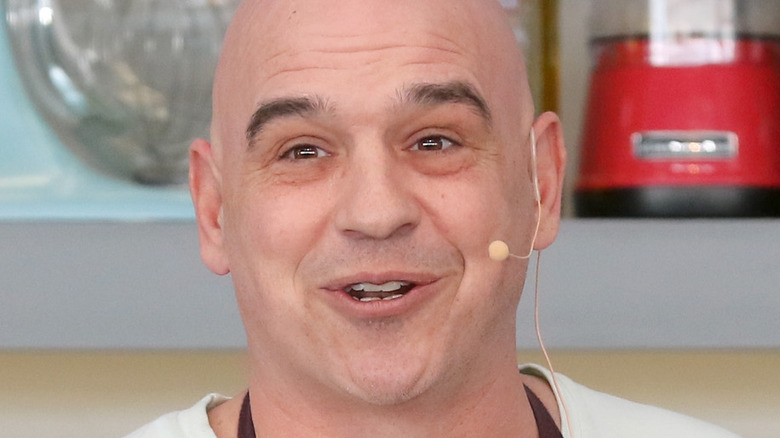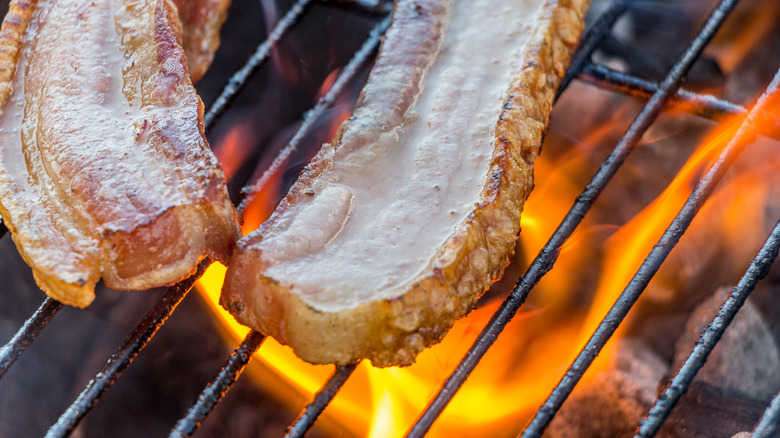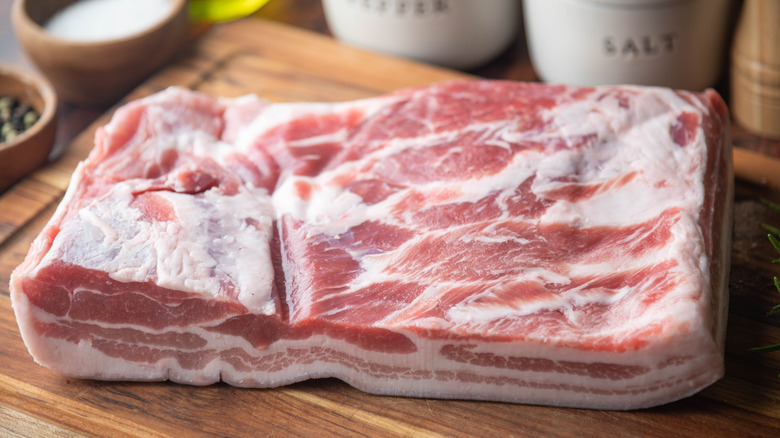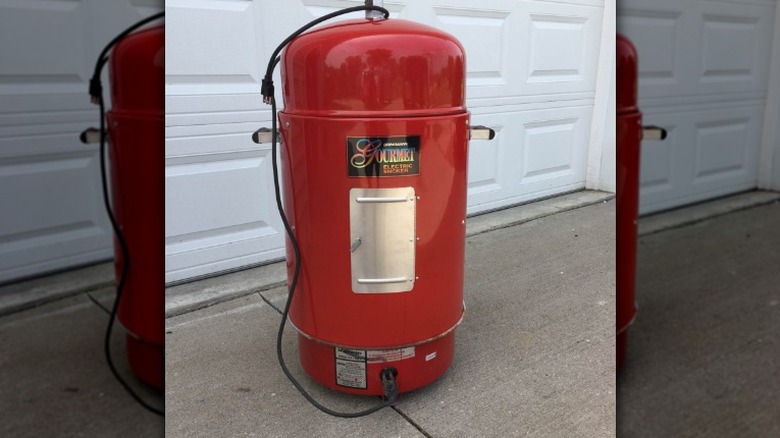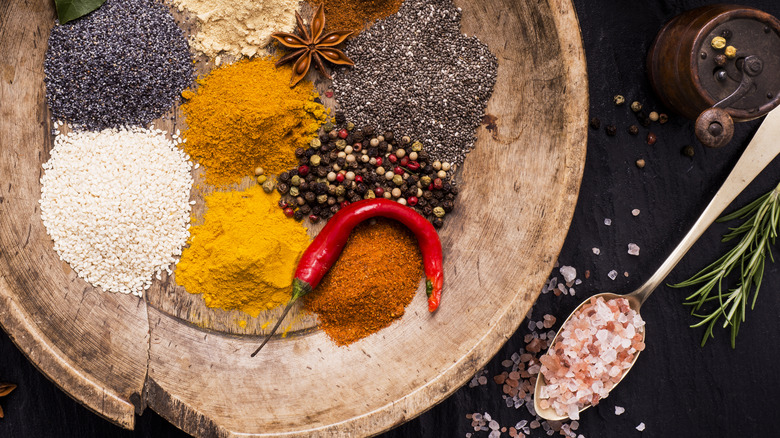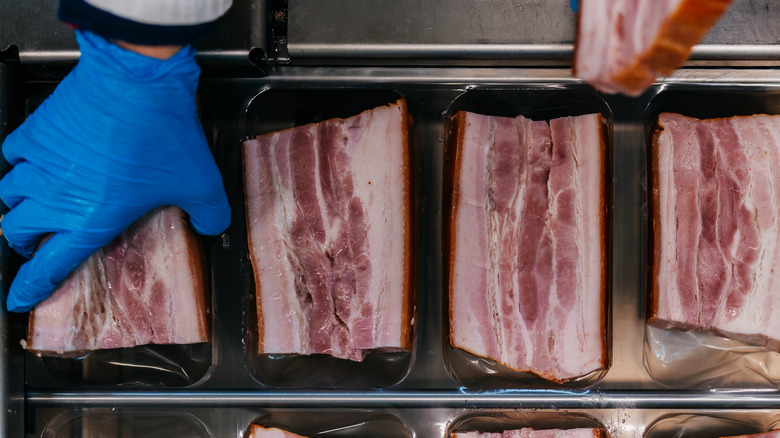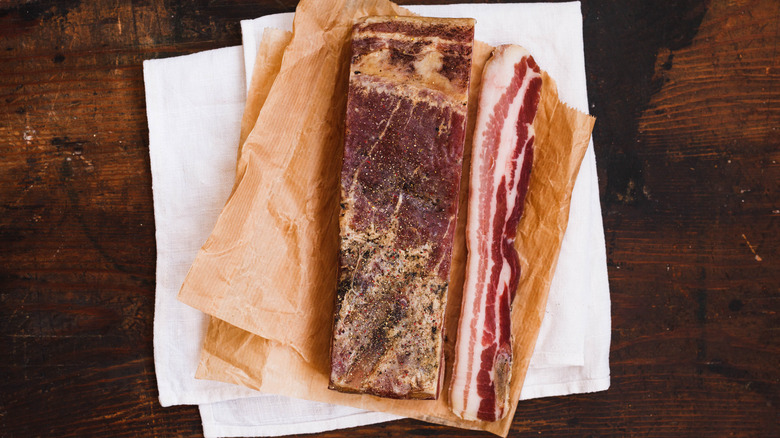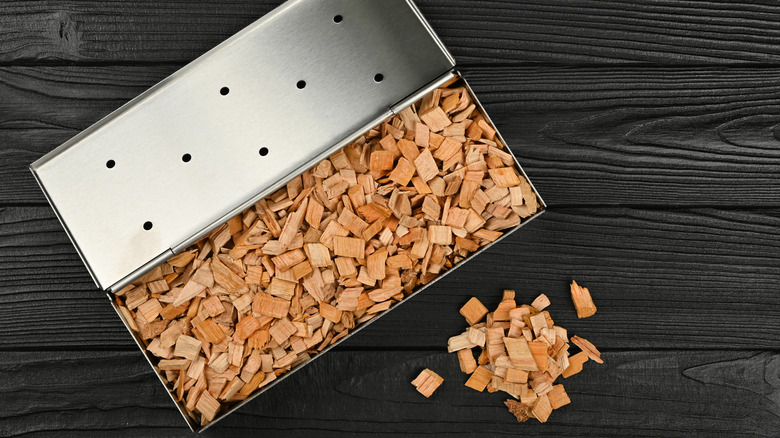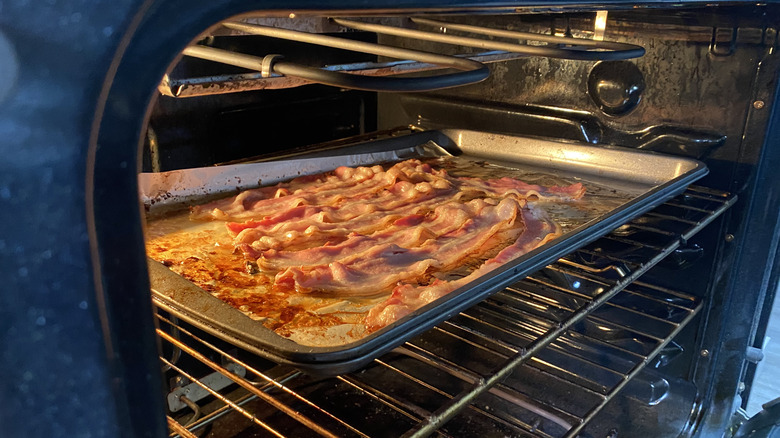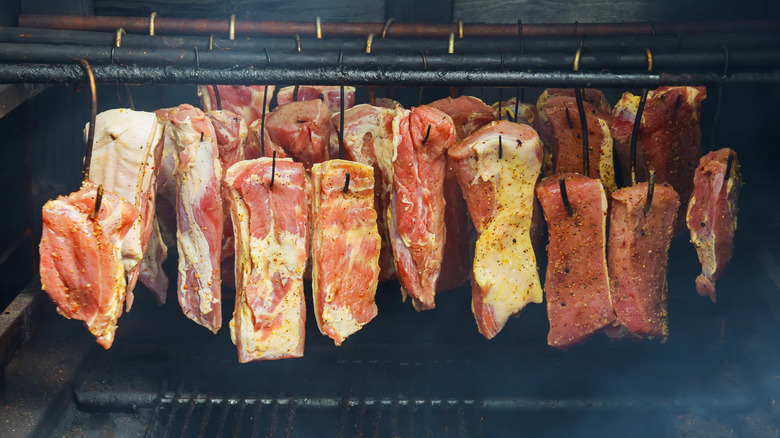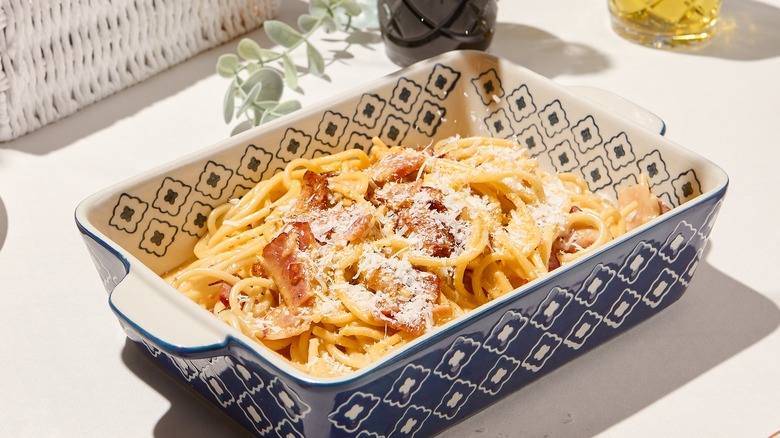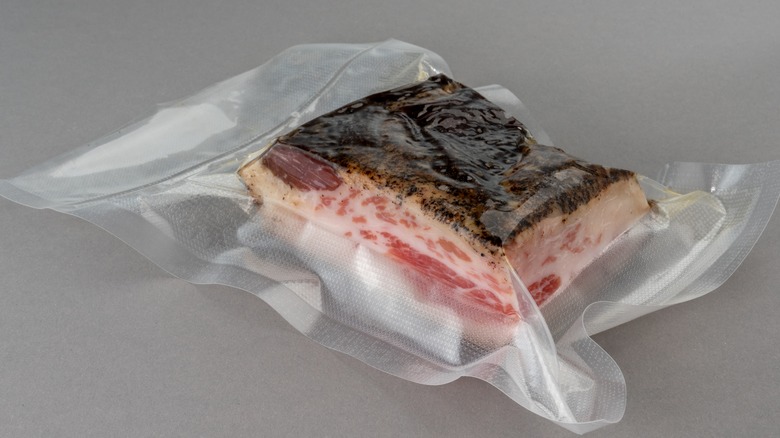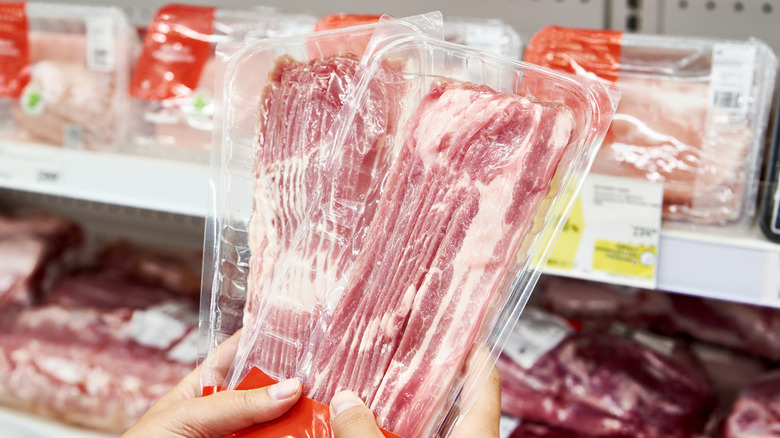Michael Symon Tells Us His Best Tips For Restaurant-Quality Bacon At Home - Exclusive
Chef and Food Network star Michael Symon is a forefather of America's butchery revolution. His Cleveland restaurant, Lola Bistro, put nose-to-tail cooking on the map and was followed by staples such as Mabel's BBQ and the Symon-led television show "Burgers, Brew & 'Que," which continued to establish his place as one of the food world's refined, renowned voices on meat cuisines.
We wanted to know how to make high-end, restaurant-quality bacon at home, so who better to turn to than Chef Symon? Sure enough, his perspective on making bacon at home was sizzling. Throughout this conversation, Symon's delicious tips on how home cooks can produce, eat, and preserve an at-home product that tastes professional were peppered with fun stories, serious suggestions, and mouth-watering details. While we know that he left hungry, we departed the conversation with quite a few tips on how to upgrade a BLT, advance a simple carbonara recipe, or just create a side of handcrafted meats that can put the best local deli counter to shame.
This interview has been lightly edited for clarity and length.
Don't burn the house down
As Chef Michael Symon tells us, a key factor in making restaurant-quality bacon at home centers on food safety. But maybe not how you would expect.
"We had some trials and tribulations. One dear friend of mine built a smokehouse about 45 minutes from the restaurant ... It was kind of when we decided ... We're gonna start doing our own bacon. So, I put a cure on them. And he picked them up and brought them out to his smokehouse, and calls me the next day, and he goes, we have an issue."
The chef that he is, Symon imagined it came down to preparation. So he asked, "What, did I under cure them? What did we do wrong?" His friend's response, according to Symon? "The smokehouse burned down."
Per Symon, "He'd hung all these pork bellies in the smokehouse. They were so huge and rendering so much fat that the fat caught fire and took a whole smokehouse down with it. That was actually our first run at making bacon for the restaurants. We've learned a lot since then. But ... he had the smokehouse for two total weeks." This leads to Symon's first (unofficial) tip for aspiring bacon makers: "Don't burn down the smokehouse." Fortunately for the carnivorous world, this didn't send Symon's ambition up in smoke.
Find high quality pork
Chef Michael Symon can laugh about his first misadventure with ease, but the thing that pulled him towards trying his hand at bacon-making was — and still is — a serious consideration within his process. He recommends that it should be for yours, as well. As Symon tells Tasting Table, "I think the first key is, if you're gonna' make your own bacon, don't buy commodity pork."
After all, it was high-caliber meat that inspired Symon's first bacon run: "We had these insane pork bellies. They were mostly fed on acorn. They were incredibly thick. The fat was this pearly white." It's those same markers of quality that Chef Symon suggests that home cooks search for when sourcing meat for their bacon process. "I tend to like a little bit bigger bellies for smoking bacon than if I'm doing a braised pork belly. So thicker — a more substantial belly. You should look for fat that is white or as white as possible. It shouldn't be a yellow fat hog."
Symon tells us that it's important to source your pork from someone who can verify what sort of diet the hogs were brought up on. Foraged foods, rather than grain feeding, can ensure that the size and color of the belly match ideal traits. Additionally, meeting your local hog farmers can also help you get a read on whether the animals were humanely raised and slaughtered and if they are a heritage breed.
Start with an electric smoker
Even before you have a fine pork belly in hand, you need the equipment to cook it with. Michael Symon has seen the tools of the trade evolve over the years. "In 97'-98', they just didn't have the tools that they have now ... You couldn't buy these reverse flow smokers ... We were doing it with live fire and in a building that we fabricated."
Luckily, the average home cook has more options than challenging live fire. Instead, Symon recommends low-input devices for making restaurant-quality bacon at home. "I think for the home smoker, an electric smoker is probably the best way to go. Because it's very easy to control the temperature." In contrast, offset smokers require a skilled hand. "I do it at home in my offset smoker, but you know, I've also been using that offset smoker for close to 30 years now. So I know how to manipulate the heat and things that I could do to drop it down and so forth."
To give home bacon-making an easier chance of success, Chef Symon advises home cooks to avoid unnecessary challenges. He tells Tasting Table that relying on an electric smoker with preset temperature options takes one variable out of the process. These days, a small electric unit can go for under $125 while still allowing for a wide range of personal touches in how you smoke your bellies.
Don't be afraid to get creative with seasoning
There are many reasons to appreciate bacon. Between the texture and salinity, the fundamental smokiness, it's a comfort food that reminds us of familiar situations and calls back to primal cravings. For Chef Michael Symon, the well-acquainted taste is a forgiving place for cooks to try an added gastronomic touch. He tells Tasting Table, "With flavor profiles, I think it's best people continue to play around with that, to customize it to their own likings."
Personally, Symon looks for seasonings that serve dual purposes. "I like celery seeds, so I tend to put a little bit of celery seed in mine, which celery is also something that helps the curing process, so never a bad addition." He doesn't stop there. "I love coriander. I tend to put it in there. I like spicy, so I'll find some kind of chili that I like to work in, whether it's an Aleppo or an Urfa or even a chili flake. But obviously, those kinds of things are optional ingredients depending on what someone is looking for in the bacon."
The chef also has tips for those with a sweet tooth. For those who like a more saccharine note to their breakfast meet, he suggests working in brown sugar, which can make up the primary sweetener for balancing out your cure. And if you're looking to take that flavor profile even deeper, Symon recommends adding maple syrup for a layered complexity.
Keep rotating your belly as it cures
Conventional bacon-making wisdom would have you believe that once you've rubbed the cure and seasoning into the pork belly, you can take a load off. Although Chef Michael Symon doesn't claim that you should hover over yours like a hungry hawk, he does call for a (somewhat) light hand in the curing process.
As the chef notes, home cooks will start their bacon process the same way any restaurant chef would. First, you apply a cure to your meats, then stash them in a container — resealable bags or nonreactive pans are common vessels. Once the meat is covered, the cure begins to pull moisture from the product. When you notice this moisture leaching, you're at the point where Symon states attention is needed.
"You want to make sure that you keep rotating it, so one side doesn't get submerged in the liquids that are coming out and cures quicker than the other side. I think that's a very important point that sometimes people miss out on." Symon also recommends anchoring down the belly. "I like to weigh it a little bit as I'm going through the cure because the belly itself usually is slightly uneven in its thickness. If you put a little bit of weight on there, it'll make it a little bit more even. Which I think helps with the cure."
Consider skipping the belly's bath
For those out there who haven't yet tried to make their own bacon from scratch but have visualized the process, you've likely conjured images of rolling smoke and flickering flame (especially if you've been following Michael Symon's story from the beginning). As a crisp food, it's unlikely that the moistening effect of water has factored much into your picture of sizzling bacon.
However, water is an important part of the journey that fresh pork belly takes from the smoker to your plate. Per Symon, "You want to rinse off the cure before you get it in [the smoker] to eliminate some of that saltiness." Solid advice, considering bacon is a common food loaded with salt. Even turkey bacon, regarded as the "healthier" alternative, has exceptionally high levels of sodium. That said, a pre-smoke shower can cut some of the brine if that's what you're looking for.
Still, Michael Symon doesn't recommend too much water if you want to give restaurant-quality to your bacon. Speaking about what to do with the pork belly in the post-cure, pre-smoke stage, he tells Tasting Table about his preference. "Some people recommend soaking [the belly] for a good amount of time to pull even more of that salt out of there. I personally don't typically soak, I just rinse and go." When we asked why, Symon's answer offered an honest reasoning. "I like a little bit of that salinity that is there." As do we, Chef.
Know what your wood chips are bringing to the party
Masters of meat arts might be expected to wax poetic about the creative expressions within one's choice of bacon-making components. You know, "All bacon is a stage, and all the curing salts and wood chips merely players." While we could listen to an audiobook of Michael Symon's smooth voice extolling the virtues of good bacon, he's more direct about what things like wood chips can deliver.
For restaurant-quality bellies, consider the nuances of wood types. Symon says, "What I would suggest to people is if you want something really smoky, you want your chips to be mesquite, hickory, or even pecan. If you want something with a slightly milder, sweeter smoke, you want to go with fruit woods. So applewood, cherry, peach woods, those are going to give you a gentler smoky flavor. And if you want to be somewhere in the middle, you can go half and half with both of those."
Symon tells us that inspiration can even be pulled from other smoked meat cuisines. From his perspective, the great popularity of Texas-style barbecue has created believers in the moderately gentle smoke that's imparted by different types of oak chips. However, he notes that oak wood's biggest virtue is bringing an even heat to the smoker rather than delivering a big, bold flavor. For bacon, oak can be relied on for "the middle of the road smoke," but not much more in the way of taste.
How you cook might depend on who you serve
By some estimates, the origin of bacon goes back to 1,500 BCE, when the Chinese began salting pork for preservation. With such a long and storied history, there are bound to be strong opinions on how to prepare, cook, and best consume bacon. For all the tips out there on how to best get this meat to your tastebuds, there are as many common mistakes people make when cooking bacon. Chef Michael Symon has served his fair share of bacon in restaurant settings, so when Tasting Table asked him how he prefers to provide that professional quality at home, he was ready with a straightforward answer.
For cooking bacon, Symon recommends considering how many people you're going to serve. "I like doing it in a pan on the stove for one to two people. I'll make it in the oven for larger parties." While that might bring up some contention from the many sides of the great bacon cooking argument, Chef Symon went on to give a suggestion for how he prepares bacon on the stovetop. "It's also one of the few things I start in a cool pan on the stove, turn the heat to medium, and gently crisp." As expected, Symon has wise reasoning for this suggestion. Cooking your product in a cold pan lets the fat render slowly, allowing the bacon to become crackly while cooked in its own oils.
Don't be intimidated by the process
The longevity of bacon in the human diet may open it up for varied debates on preparation, but it also signals that this meat is a relatively easy thing to create. After all, it has remained in near-perpetual accessibility even during times of limited resources and tools, which leads to another of Michael Symon's tips for making high-caliber products at home. Remember that it's the ease of bacon-making that has kept this meat form around for centuries.
Per Symon, "I gotta tell you, other than me burning down the smokehouse, there's not a lot that could really go wrong. If you under-cure it, it's still gonna be delicious — it's just not gonna last as long after it's cooked, after it's smoked. And, if you over-cure it, it's just going to be a little bit saltier and a little bit firmer. It takes time. But, it's incredibly simple."
Listening to Chef Symon talk about the process, it's clear that the best thing a home cook can do is remember what they're preparing. In his words, bacon-making has distinct differences from other cured meat products. It's not a complex process, like salami, where the duality of using ground meat without cooking can combine to create ripe grounds for bacteria. Instead, the Mabel's BBQ chef tells Tasting Table, "With something like bacon, where it's a cut of meat ... you're actually bringing heat to the party, you're in a pretty good place."
Think of your bacon as an ingredient
Michael Symon is widely known as Food Network's resident "meat guy." So, we were surprised when he offered up this specific tip for restaurant-quality home bacon.
"I don't eat a lot of just cooked bacon with eggs, so to speak. I tend to use bacon in dishes ... where it's a flavor booster to a dish, as opposed to just a side of it with my eggs." Trigger warning for what you may read next, but according to the carnivorous chef, "Even when I have, like, the classic New York egg sandwich, I like just an egg and cheese sandwich."
As Symon says, a good way to give your bacon that out-for-dinner quality is to think like a chef. He elaborates, "Italian carbonara is made with guanciale, which is the jowl of the meat ... I typically use my own bacon for it ... I like the smokiness that it brings to the pasta dish."
Continuing to explain how he turns his home bacon into a restaurant-worthy ingredient, Chef Symon gave us a few tips and other suggestions on what to prepare. If you're making slab bacon, he recommends cutting the belly into large lardon cubes, which can serve a variety of purposes. Consider throwing those chunks in with hardy greens, like kale or chard, and watch as the rendered fat makes a mouthwatering side dish — or add the smokey salinity of bacon into a rich bowl of bean soup.
Consider a vacuum-sealer for preservation
There are a lot of reasons to consider making bacon at home. Less preservatives, a more economical approach at a time when grocery bills are on the rise, and even just having a better tasting, restaurant-like flavor to your home ingredients. One tip Chef Michael Symon has for bringing restaurant-quality bacon into your kitchen is to keep your product in stock at all times.
Symon explains to Tasting Table: "It's something that you could do large batches of, and it freezes brilliantly. So, if you got four beautiful bellies, smoke four beautiful bellies, and there — you Cryovac those bellies, they're going to last in your fridge for minimally a month, but they could last in the freezer for six months."
When recommending how to keep your bacon on hand, the meat-centric chef doubled down on the idea of using tools like vacuum packaging to preserve your goods. As he notes, as accessibility of vacuum sealers has resulted in a glut of options and lower unit costs for the average home cook. Inexpensive sealers will allow you to extend the shelf-life of your bacon without risking freezer burn.
For those not ready to take the vac-seal approach, Symon has an answer. "Certainly if you don't have one of those or don't want to purchase one of those, make sure if you're using a Ziploc type of bag, you get as much air out of that bag as possible. Because that's the enemy, so to speak."
If you're buying pre-made bacon, look for these things
Finally, we realize that not every home cook has taken steps to buy a smoker, load up on curing salts and wood chips and heritage pork belly, to get down to producing bacon from scratch. So, we asked Chef Michael Symon the question, "what would you advise folks who want to make restaurant-quality stuff from their pre-packaged bacon?"
According to Symon, here's what home cooks should do. "If you could buy a whole belly, best case scenario, and slice it yourself because then you can control the thickness. If you can't buy a whole belly, buy the thickest slices that you could find. They just tend to be a little bit higher quality." If your local grocer doesn't have a lot of options in this regard, Chef Symon recommends looking in specialty stores and mail-order meat programs.
"There's a famous deli out of Michigan that has a bacon of the Month Club, and every month they send you a different artisanal bacon from around the country. Super fun. You get to try a bunch of different styles, some belly, some jowl, something excellent."
The deli in question? Zingerman's Mail Order Bacon Club. According to its website, Symon once lauded this package as "the best thing I ever ate." Coming from someone who tells us that Tom Colicchio's was the finest bacon he's ever tried in a restaurant, you've got to wonder, how's that for restaurant quality?
